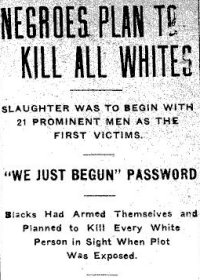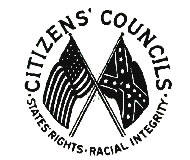Related Research Articles

The Elaine massacre occurred on September 30–October 2, 1919 at Hoop Spur in the vicinity of Elaine in rural Phillips County, Arkansas. As many as several hundred African Americans and five white men were killed. Estimates of deaths made in the immediate aftermath of the Elaine Massacre by eyewitnesses range from 50 to "more than a hundred". Walter Francis White, an NAACP attorney who visited Elaine shortly after the incident, stated "... twenty-five Negroes killed, although some place the Negro fatalities as high as one hundred". More recent estimates in the 21st century of the number of black people killed during this violence are higher than estimates provided by the eyewitnesses, and have ranged into the hundreds. Robert Whitaker estimated 856 people were killed in his 2008 book on this topic. The white mobs were aided by federal troops and local terrorist organizations. Gov. Brough led a contingent of 583 US soldiers from Camp Pike, with a 12-gun machine gun battalion.

Scipio Africanus Jones was an American educator, lawyer, judge, philanthropist, and Republican politician from the state of Arkansas. He was most known for having guided the appeals of the twelve African-American men condemned to death after the Elaine Massacre of October 1919. More than one hundred African Americans were indicted in the aftermath of the riot, although an estimated one hundred to two hundred Black Americans were killed in the county, along with five whites. No whites were prosecuted by the state. The case was appealed to the United States Supreme Court, which in Moore v. Dempsey (1923) set a precedent of reviewing the conduct of state criminal trials against the Due Process Clause of the Fourteenth Amendment to the United States Constitution.
The Arkansas Gazette was a newspaper in Little Rock, Arkansas, that was published from 1819 to 1991. It was known as the oldest newspaper west of the Mississippi River. It was located from 1908 until its closing at the now historic Gazette Building. For many years it was the newspaper of record for Little Rock and the State of Arkansas. It was Arkansas' first newspaper.

Elizabeth Ann Eckford is one of the Little Rock Nine, a group of African-American students who, in 1957, were the first black students ever to attend classes at the previously all-white Little Rock Central High School in Little Rock, Arkansas. The integration came as a result of the 1954 United States Supreme Court ruling Brown v. Board of Education. Eckford's public ordeal was captured by press photographers on the morning of September 4, 1957, after she was prevented from entering the school by the Arkansas National Guard. A dramatic snapshot by Will Counts of the Arkansas Democrat showed the young girl being followed and threatened by an angry white mob; this and other photos of the day's startling events were circulated around the US and the world by the press.

The Citizens' Councils were an associated network of white supremacist, segregationist organizations in the United States, concentrated in the South and created as part of a white backlash against the US Supreme Court's landmark Brown v. Board of Education ruling. The first was formed on July 11, 1954. The name was changed to the Citizens' Councils of America in 1956. With about 60,000 members across the Southern United States, the groups were founded primarily to oppose racial integration of public schools: the logical conclusion of the Brown v. Board of Education ruling.

Daisy Bates was an American civil rights activist, publisher, journalist, and lecturer who played a leading role in the Little Rock Integration Crisis of 1957.

Minnijean Brown-Trickey is an American political figure who was a member of the Little Rock Nine, a group of nine African American teenagers who integrated Little Rock Central High School. The integration followed the Brown v. Board of Education decision which required public schools to be desegregated.

Melba Joy Patillo Beals is an American journalist and educator who was a member of the Little Rock Nine, a group of African-American students who were the first to racially integrate Little Rock Central High School in Little Rock, Arkansas.
Lucius Christopher Bates was an African-American civil rights activist and the husband of Daisy Bates.

Harry Scott Ashmore was an American journalist who won a Pulitzer Prize for his editorials in 1957 on the school integration conflict in Little Rock, Arkansas.

The Daisy Bates House is a historic house at 1207 West 28th Street in Little Rock, Arkansas, USA. It is significant as the home of Arkansas NAACP president Daisy Bates, and for its use as a command post for those working to desegregate the Little Rock Central High School during the desegregation crisis of 1957–1958. It was a sanctuary for the nine students involved. It was declared a National Historic Landmark in 2001.

The Little Rock Nine were a group of nine African American students enrolled in Little Rock Central High School in 1957. Their enrollment was followed by the Little Rock Crisis, in which the students were initially prevented from entering the racially segregated school by Orval Faubus, the Governor of Arkansas. They then attended after the intervention of President Dwight D. Eisenhower.

The National Association for the Advancement of Colored People (NAACP) is a civil rights organization in the United States, formed in 1909 as an interracial endeavor to advance justice for African Americans by a group including W. E. B. Du Bois, Mary White Ovington, Moorfield Storey and Ida B. Wells. Leaders of the organization included Thurgood Marshall and Roy Wilkins.
The Arkansas Negro Boys' Industrial School (1927-1968) was a juvenile correctional facility for black male youth in Arkansas. There were two locations in 1936, one in Jefferson County and one in Wrightsville 10 miles (16 km) southeast of Little Rock. A fire in 1959 at the children's dormitory killed twenty-one victims.
Hocutt v. Wilson, N.C. Super. Ct. (1933) (unreported), was the first attempt to desegregate higher education in the United States. It was initiated by two African American lawyers from Durham, North Carolina, Conrad O. Pearson and Cecil McCoy, with the support of the National Association for the Advancement of Colored People (NAACP). The case was ultimately dismissed for lack of standing, but it served as a test case for challenging the "separate but equal" doctrine in education and was a precursor to Brown v. Board of Education, 347 U.S. 483 (1954).
Jerry Donal Jewell (1930–2002) was an American dentist and politician who was the first African American to serve in the Arkansas Senate in the twentieth century. He also served as acting governor of Arkansas for four days while Governor James Guy Tucker was out of state to attend former governor Bill Clinton's inauguration as president of the United States. He was a Democrat.
Christopher Columbus "C.C." Mercer was an African-American attorney from Arkansas. He was one of the "six pioneers" who integrated the University of Arkansas Law School. As an attorney, he served as an NAACP field representative to advise Daisy Bates, who spearheaded the efforts of the Little Rock Nine who integrated Little Rock Central High School.

African Americans have played an essential role in the history of Arkansas, but their role has often been marginalized as they confronted a society and polity controlled by white supremacists. During the slavery era to 1865, they were considered property and were subjected to the harsh conditions of forced labor. After the Civil War and the passage of the 13th, 14th, and 15th Reconstuction Amendments to the U.S. Constitution, African Americans gained their freedom and the right to vote. However, the rise of Jim Crow laws in the 1890s and early 1900s led to a period of segregation and discrimination that lasted into the 1960s. Most were farmers, working their own property or poor sharecroppers on white-owned land, or very poor day laborers. By World War I, there was steady emigration from farms to nearby cities such as Little Rock and Memphis, as well as to St. Louis and Chicago.
Roy Vincent Harris was an American politician and newspaper publisher in the U.S. state of Georgia during the mid-1900s. From the 1920s until the 1940s, Harris served several terms in both the Georgia House of Representatives and the Georgia State Senate, and he served as the speaker of the house from 1937 to 1940 and again from 1943 to 1946. Historian Harold Paulk Henderson has called Harris "one of Georgia's most capable behind-the-scenes politicians".

Black Boys Burning: The 1959 Fire at the Arkansas Negro Boys Industrial School is a 2017 non-fiction book by Grif Stockley, published by University Press of Mississippi. It is about the deadly fire at the Arkansas Negro Boys' Industrial School.
References
- 1 2 3 4 5 Smith, C. Calvin (1982). "L.C. Bates: Newsman and Civil Rights Activist". Negro History Bulletin. 45 (4): 98–114. ISSN 0028-2529. JSTOR 44176536.
- 1 2 3 "The Daisy Bates Papers (MC 582) | University of Arkansas Libraries". libraries.uark.edu. Retrieved 2019-05-25.
- 1 2 3 4 Stockley, Grif. "Arkansas State Press". The Encyclopedia of Arkansas History & Culture . Retrieved November 1, 2013.
- ↑ Kirk, John (1 February 2012). "The history of the sit-in movement in Little Rock". Arkansas Times. Retrieved 20 July 2020.
- 1 2 Wassell, Irene (1983). L.C. Bates, editor of the Arkansas State Press. University of Arkansas at Little Rock. Department of Journalism. Retrieved 19 July 2020.
- ↑ "Arkansas State press. [volume]". Library of Congress. Retrieved 19 July 2020.
- ↑ "Arkansas State Press | fsu.digital.flvc.org". fsu.digital.flvc.org. Vol. 15, no. 19. Arkansas State Press. 9 September 1955. Retrieved 20 July 2020.
- ↑ Stockley, Grif (28 July 2017). Black boys burning : the 1959 fire at the Arkansas Negro Boys Industrial School (Hardcover ed.). University Press of Mississippi. p. PT126. ISBN 978-1496812698.
- 1 2 Bates, Daisy; Gatewood, Willard B.; Carson, Clayborne (1986). The Long Shadow of Little Rock: A Memoir. University of Arkansas Press. ISBN 978-1-55728-863-9. JSTOR j.ctt1ffjfcq.